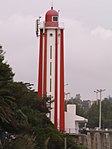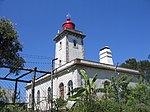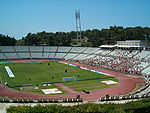Gibalta rail accident
1952 in PortugalDerailments in PortugalMarch 1952 events in EuropeOeiras, PortugalRailway accidents in 1952

The Gibalta rail accident occurred on 31 March 1952, on the Linha de Cascais (Cascais line) in Portugal. It was a derailment due to landslides caused by adverse weather conditions and the bad conservation status of the surrounding land. The accident resulted in 10 dead and 38 injured.
Excerpt from the Wikipedia article Gibalta rail accident (License: CC BY-SA 3.0, Authors, Images).Gibalta rail accident
Avenida Marginal, Oeiras e São Julião da Barra, Paço de Arcos e Caxias
Geographical coordinates (GPS) Address Nearby Places Show on map
Geographical coordinates (GPS)
| Latitude | Longitude |
|---|---|
| N 38.699444444444 ° | E -9.2663888888889 ° |
Address
Avenida Marginal
Avenida Marginal
2760-064 Oeiras e São Julião da Barra, Paço de Arcos e Caxias
Portugal
Open on Google Maps





